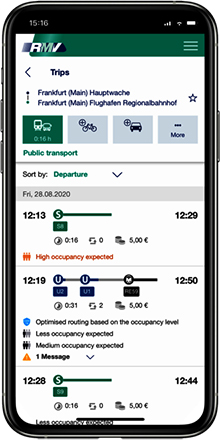Predicting public transport occupancy with big data: Steven Ahlig tells all
- Like
- Digg
- Del
- Tumblr
- VKontakte
- Buffer
- Love This
- Odnoklassniki
- Meneame
- Blogger
- Amazon
- Yahoo Mail
- Gmail
- AOL
- Newsvine
- HackerNews
- Evernote
- MySpace
- Mail.ru
- Viadeo
- Line
- Comments
- Yummly
- SMS
- Viber
- Telegram
- Subscribe
- Skype
- Facebook Messenger
- Kakao
- LiveJournal
- Yammer
- Edgar
- Fintel
- Mix
- Instapaper
- Copy Link
Posted: 25 November 2020 | Steven Ahlig - Hacon | No comments yet
Steven Ahlig, Vice President Innovations at Siemens Mobility, explains how public transport services can get back to normal after the pandemic, and how travel apps can use data to predict transport occupancy rates.


The new technology enables passengers to see the predicted occupancy of their route. Credit: iStock.com /YurolaitsAlbert.
Will public transport occupancy be the same as it was prior to COVID-19?
Yes, we think that passenger numbers will eventually get back to what we were seeing before the pandemic. In the long-term, we actually expect it will be even higher because in all major cities public transport is the backbone of mobility. Transport companies can manage this with transparency, information and active risk management to some degree.
What can transport companies do to encourage passengers to return to public transport?
Well, we think it is crucial that transport companies actively manage the situation. Several things can be done: basic measures, like clear information about COVID-19 rules are undoubtedly a good start. However, it is also important to monitor and enforce adherence to restrictions in public transport.
Some operators have set upper limits for occupancy of vehicles to allow for social distancing during the pandemic and schedule additional lines and vehicles for that purpose. A very effective way is also predictions on vehicle occupancy. Passengers use this information very actively to choose connections that are less occupied. So there are a range of measures that transport operators can use to increase trust during the pandemic.
Made to measure: how smart ticketing solutions and tailored travel suggestions enhance the passenger experience
Find out more about the ways that Siemens and Hacon are helping transport operators and authorities recover from the impact of the pandemic through smart ticketing technology and better information services for passengers in our on-demand webinar.
How can travel apps anticipate the likely occupancy of public transport services ahead of time?
Travellers use journey planning apps for different purposes, but the main purpose is, well, journey planning. If, for example, a traveler intends to go from his home to a specific address tomorrow morning, he or she may ask his journey planning app to provide travel options and connections for the intended time of travel. In a larger city, this is done by many people per day, and collectively these journey planning requests indicate a travel demand for the near-term future.
So the challenge is to collect the data that is generated by these journey planning requests and analyse it to extract this information. In a large city like Berlin, and with a popular HAFAS app, there are millions of requests per day. Working with such a data set needs big data technologies – so this is part of our solution. We collect the data that is generated by the journey planning requests in real-time and in a fully anonymised way.


This is what passengers travelling on the RMV network in Frankfurt will see when planning their route.
This data has been used in the past to build and train a machine learning system which looks for patterns, such as variances in occupancy depending on time, day of the week, bank holidays, weather and, in particular, depending on journey planning requests. We use samples of actual occupancy numbers to calibrate the results.
In a nutshell, our solution has a machine learning system at the core, which is trained using the historical data. The HAFAS data provides insights on the travel demand of the near-term future, and the combination of all this provides predictions on occupancy in public transport vehicles.
Biography
Steven Ahlig is Vice President of Innovations at Siemens Mobility. Three years ago, Hacon, a software company providing cutting-edge digital solutions for public transportation, mobility and logistics, became a 100% subsidiary of Siemens. With that acquisition, Steven became Executive Director at Hacon.
He is a member of the Siemens family for nearly twenty years now and has started his career in Consultancy in 2001. His background includes data analytics, IT for travelers and transport operators, ticketing and R&D in general. Steven holds a PhD in physics.
Related topics
Artificial Intelligence, Intelligent Transport Systems (ITS), Journey Planning, Passenger Experience, Public Transport, Travel & Passenger Information
Related modes
Bus & Coach, Light Rail, Metro
Related organisations
Hacon A Siemens Company, Rhein-Main-Verkehrsverbund (RMV)
Related people
Steven Ahlig








